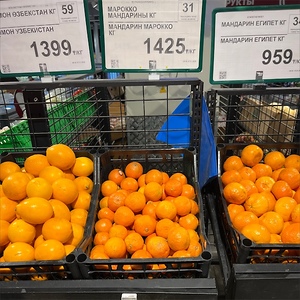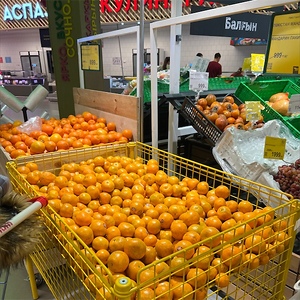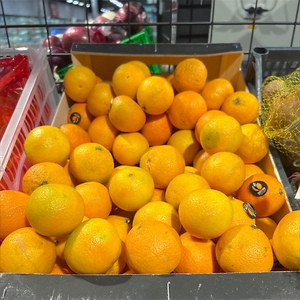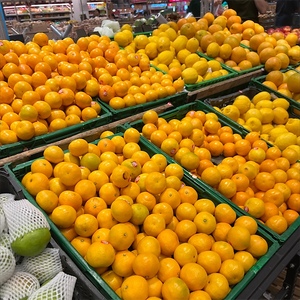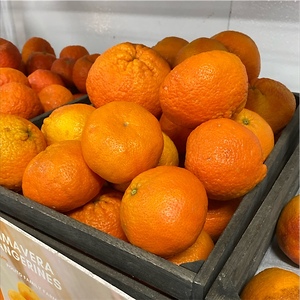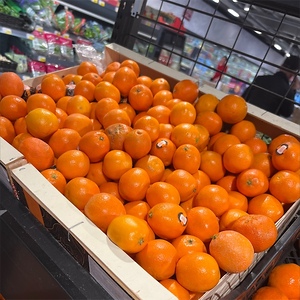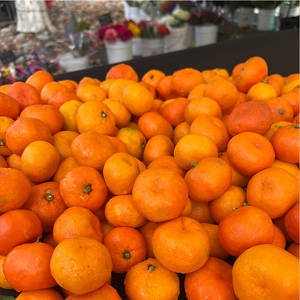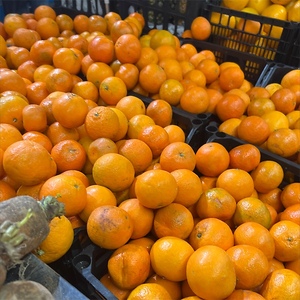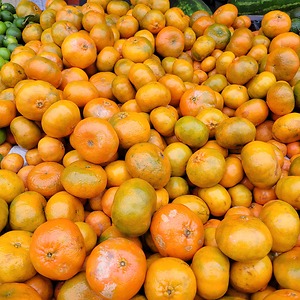


Tangerines
Estimated Inventory, lb : 0
Description/Taste
Tangerines are small to medium-sized fruits, averaging 5 to 8 centimeters in diameter, and have a flattened, oblate to obovoid appearance. Some Tangerine varieties may showcase a small neck on the stem end, and the peel is thin with a smooth, slightly leathery, and textured surface, covered in prominent oil glands creating a pebbled look. The peel also ranges in color from bright orange to dark orange-red and is loosely attached to the flesh, easily peeled and removed. Underneath the surface, the flesh is divided into 10 to 12 segments by thin white membranes and is aqueous, tender, and vibrant orange, being found seedless or containing cream-colored seeds. Tangerines should feel heavy for their size when ripe and have a soft feel when gently squeezed. The fruits are aromatic, and the flesh has a bright and refreshing, sweet to sweet-tart flavor, depending on the specific variety.
Seasons/Availability
Tangerines are available in the late fall through winter.
Current Facts
Tangerines, botanically classified as Citrus reticulata or Citrus tangerina, depending on the classification system, are sweet-tart fruits belonging to the Rutaceae family. Scientists have heavily debated how to categorize these fruits throughout history, but the term Tangerine generally describes a subspecies of mandarin oranges that were first introduced to the United States from the port of Tangiers in Morocco in the 19th century. After their introduction, Tangerines became a favored citrus among commercial growers, and several new varieties were created, expanding Tangerine cultivation worldwide. Tangerines are also distinct from commercial oranges, classified as separate species, and are favored among consumers for their more robust sweet-tart flavor, easy to peel nature, and juicy flesh. The dark red-orange, oblate fruits are sometimes generally labeled as Mandarins in commercial markets, but it is important to note that these descriptors cannot be used interchangeably as not all mandarin species are Tangerines. Despite their botanical confusion, there are many different varieties of Tangerines, with Sunburst and Dancy being the two most popular for commercial production. There are also several well-known hybrid Tangerine cultivars, including tangors, a cross between a Tangerine and a grapefruit, and tangelos, a cross between oranges and Tangerines. Many of these hybrid varieties are seedless or seeded and are promoted under the marketing names of Clementines, Murcotts, Minneolas, and Satsumas. In modern-day markets, consumers are no longer purchasing fruits generally labeled as Tangerines but are instead seeking out specific varieties, leading retailers to label Tangerines by their individual branding names for a more personalized experience.
Nutritional Value
Tangerines are an excellent source of vitamin C to strengthen the immune system while reducing inflammation and provide vitamin A to maintain healthy organ functioning. The fruits also contain potassium to balance fluid levels within the body, calcium and phosphorus to protect bones and teeth, and other nutrients, including zinc, manganese, folate, and B vitamins.
Applications
Tangerines have a sweet-tart flavor well suited for fresh and cooked preparations. The fruits are easy to peel, allowing them to be consumed straight out of hand. Tangerines are also segmented and tossed into green salads, fruit bowls, stirred into yogurt, or sprinkled over stir-fries for a pop of flavor. In addition to using the flesh whole, Tangerines can be pressed into juice and mixed into vinaigrettes, marinades, and salad dressings. The liquid can also be stirred into cocktails, mixed into fruit drinks, or blended into smoothies. In commercial markets, Tangerine juice can be sold by itself fresh or frozen from concentrate. Try incorporating Tangerine segments into baked goods, used as an edible garnish over desserts such as cakes, or simmered into jams and other preserves. Beyond the flesh, the peel can be zested fresh as added flavoring over rice and roasted meats or dried and combined with spices as additional zest. The peel can also be candied as a sweet snack. Tangerines pair well with aromatics such as ginger, garlic, scallions, and shallots, fruits including strawberries, pineapple, bananas, and mangoes, nuts such as almonds, pecans, and pistachios, honey, and meats including poultry, pork, and beef. Whole, unwashed Tangerines will keep up to one week when stored at room temperature and 1 to 2 weeks when kept in the refrigerator.
Ethnic/Cultural Info
Tangerines are often labeled as “Christmas fruits” as the sweet-tart citrus is at its peak during the holiday season. There are many myths and legends about how Tangerines became a popular stocking stuffer. One story can be traced back to the origins of St. Nicholas placing gold coins into the stockings of families in Europe. Over time, the gold coins turned into mandarin oranges, and the fruits were once considered extremely valuable. Citrus provided a vital vitamin C and potassium source during the bleak winter season, and many consumers would only receive a few pieces of citrus as an indulgent gift. Tangerines also became a prized gift during the Great Depression. Many families could not afford to purchase gifts, and citrus was seen as a luxury present that provided nutrients during scarcity. It was customary for citrus to be placed in stockings with walnuts throughout the 1930s. Tangerines continued to be a prized fruit during the holiday season, and in the present day in Europe and the United States, the fruits are festively placed in decorative bowls, hung on trees, dried and strung along garlands, and incorporated into a wide variety of sweet and savory dishes.
Geography/History
Tangerines are believed to be a subspecies of the mandarin orange, native to regions of Asia and Southeast Asia. Mandarins have been cultivated for thousands of years, extensively grown in India and China, and were later spread along ancient trade routes into Western Asia, the Mediterranean, and Northern Africa. Mandarins were also introduced to Australia in the 1820s. In the mid-1800s, mandarins were shipped from Tangier, a Moroccan seaport, to the United States. The imported fruits were referred to as Tangerines in honor of Tangier and were planted in groves in Palatka, Florida. Over time, Tangerines expanded in cultivation throughout Florida, eventually producing the Dancy tangerine, a famous American cultivar. Tangerines quickly increased in popularity throughout the United States and were introduced worldwide for commercial cultivation. Today Tangerines are mainly produced in China and are grown in home gardens and commercial growers in Asia, Europe, Australia, Africa, South America, and North America. In the United States, Tangerines are cultivated in Florida, California, Arizona, and Texas.
Recipe Ideas
Recipes that include Tangerines. One



